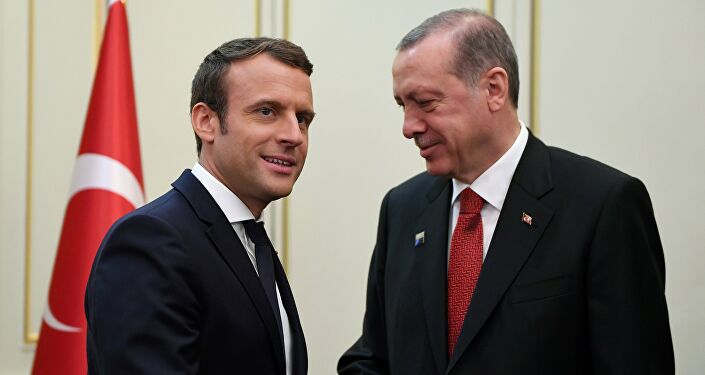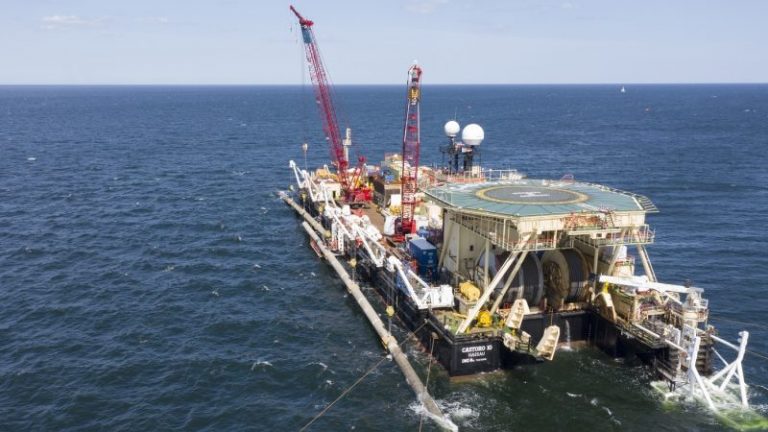MTV – Turkey-Greece conflict in eastern Mediterranean



تصاعدت التوترات بين اليونان وتركيا في الفترة الأخيرة بعدما أرسلت أنقرة سفينة للتنقيب عن النفط بالقرب من منطقة تطالب بها أثينا.
خبير الطاقة الدولي رودي بارودي أجرى في حديث لـ”سبوتنيك”، تقييماً للوضع المتفجّر بين الطرفين، فقال: إذا لم تلتزم الأطراف بالمبادئ ذاتها الناتجة عن اتفاقية الأمم المتحدة لقانون البحار، ولم تسارع إلى إيجاد أرضية مشتركة، فإن مخاطر النزاع المسلح جدية. فتركيا واليونان يمكنهما الاستئناف أمام المحاكم الدولية، ويمكنهما كذلك اللجوء إلى التحكيم إذا فشل الطرفان في الاتفاق على شكل من أشكال الإجراءات الدبلوماسية التقليدية لحل مطالبهما الإقليمية المتداخلة.
ووفق بارودي “يمكن ان يكون هناك حل عادل لكلا الطرفين، حل ينطلق من “منطق محايد” لقانون البحار، والذي تم استخدامه في مناسبات عدة في أجزاء أخرى من العالم لحل النزاعات سلمياً. ويمكن لشركات مثل Fugro التي تقدمّ حلولاً متقدّمة لرسم الخرائط و/ أو تستخدم خرائط عالية الدقة للشواطئ، أن تقدّم سريعاً “نتائج دقيقة ومتّسقة” لكل ولاية”. وتابع: هذا هو الطريق: الاعتماد على القانون والعلم والقواعد المعمول بها… وليس على التهديدات والشرائع.
وتعليقاً على الاتفاقات التي وقّعتها من أجل إعادة تحديد حدودها البحرية، تركيا مع ليبيا في عام 2019 من جهة، واليونان مع مصر في 6 آب من جهة أخرى، وما إذا كانت هذه المعاهدات معترف بها من قبل الدول المجاورة والمجتمع الدولي، قال بارودي “في الوضع الراهن، حدّدت هذه الدول الساحلية الحدود البحرية التي يبدو أنها تضمّ مناطق متداخلة ولا يزال لدى الدولتين الحق في رسم مثل هذه الحدود بموجب القانون الدولي، لكن هذه المعاهدات تلزم فقط تلك الدول التي تصادق عليها وليس دولًا ثالثة”.

La tension est à son comble entre la Grèce et la Turquie depuis l’envoi par Ankara d’un navire de recherche près d’une zone revendiquée par Athènes. Selon Roudi Baroudi, expert en énergie et des conflits en Méditerranée, si les parties ne trouvent pas rapidement un terrain d’entente, les risques d’un conflit armé sont réels. Entretien.
Rien ne va plus entre Athènes et Ankara depuis qu’un navire turc consacré à la recherche sismique a été envoyé tout près de l’île grecque de Kastellorizo. Aussi connue sous le nom de Megísti, l’île est située à deux kilomètres des côtes turques et à environ 580 kilomètres d’Athènes. Après avoir brièvement suspendu ses recherches d’hydrocarbures, Ankara a annoncé que son opération allait reprendre. Pour soutenir la Grèce, la France a décidé de renforcer sa présence dans les eaux disputées.
Pour faire le point sur cette situation explosive, Sputnik s’est entretenu avec Roudi Baroudi, spécialiste de l’énergie internationalement reconnu. M.Baroudi a notamment travaillé en collaboration avec la Banque mondiale, le FMI, la Commission européenne, l’Agence des États-Unis pour le développement international et le Fonds arabe pour le développement économique et social. Il vient de publier le livre Maritime Disputes in the Eastern Mediterranean (Éd. Brookings), consacré aux conflits en Méditerranée.
Sputnik: Est-ce le début d’un conflit majeur?
Roudi Baroudi: «La première chose à considérer est que si les parties n’adhèrent pas aux mêmes principes découlant de la Convention des Nations unies sur le droit de la mer, le différend ne peut pas prendre fin. Si tel est le cas, les 20 prochaines années ne peuvent que ressembler aux 20 dernières années: les tensions vont persister ou, pire, conduire à un réel conflit armé.
La réalité est que ces derniers jours, le navire d’exploration turc a effectué des tirs sismiques dans une zone qui ferait presque certainement partie de la Zone économique exclusive reconnue de la Turquie si les parties appliquaient les principes de la Convention des Nations unies sur le droit de la mer et respectaient celui d’équidistance. C’est un constat auquel les parties pourraient en venir si elles voulaient en arriver à une solution équitable tenant compte de toutes les caractéristiques de la zone immédiate. Autrement dit, si les deux pays s’engageaient à négocier une solution équitable ‘‘à la lettre’’, en mettant en œuvre les règles établies dans le cadre de la Convention des Nations unies sur le droit de la mer.»
Sputnik: Selon l’expert Christian Fleury, interrogé récemment par Sputnik, la Méditerranée regorge de conflits potentiels de ce type. La Méditerranée peut-elle vraiment devenir une poudrière à cause de la recherche d’hydrocarbures?
Roudi Baroudi: «Eh bien, cela est vrai en Méditerranée orientale où le conflit israélo-arabe, par exemple, dure depuis plus de 75 ans et en raison d’autres facteurs. Néanmoins, si les dirigeants de la région devaient s’asseoir et s’engager véritablement à résoudre leurs différends pacifiquement –comme ils sont tenus de le faire en vertu de la charte des Nations unies et tenus d’utiliser les structures de partenariat de l’UE disponibles–, je ne doute pas qu’ils pourraient finir par conclure des accords qui isolent la recherche de profits liée aux hydrocarbures des effets de leurs désaccords politiques.
À certains égards, cela s’applique en particulier à la Grèce et à la Turquie. Ces deux pays sont actuellement dirigés par des individus dont les référents nationalistes les encourageraient sans doute à parvenir à un accord. Il est important de noter que si la Grèce et la Turquie ont déclaré unilatéralement leurs frontières maritimes hypothétiques, aucune de leurs revendications n’a été enregistrée, publiée ou même déposée auprès de la Division des affaires maritimes et du droit de la mer des Nations unies, ce qui signifie qu’elles ne sont pas reconnues internationalement.
Il existerait une solution équitable pour les deux parties, celle qui procède d’une ‘‘logique neutre’’ du droit de la mer et qui a été utilisée à plusieurs reprises dans d’autres parties du monde pour résoudre pacifiquement des conflits similaires. Cette solution tiendrait compte des petites îles grecques isolées tout en offrant le meilleur compromis aux deux États côtiers pour l’ensemble de la mer Méditerranée.»
Sputnik: Selon vous, la Turquie et la Grèce devraient donc faire appel aux tribunaux internationaux?
Roudi Baroudi: «C’est définitivement une option, tout comme l’arbitrage, si les parties ne parviennent pas à se mettre d’accord sur une forme de procédure diplomatique conventionnelle pour résoudre leurs revendications territoriales qui se chevauchent. Quelle que soit la manière de dialoguer, tant qu’ils acceptent de suivre les principes de la Convention des Nations unies sur le droit de la mer, les progrès récents de la technologie rendent le résultat des négociations beaucoup plus prévisible qu’il ne l’aurait été auparavant.
Des entreprises comme Fugro offrant des solutions de cartographie avancées et/ou utilisant une cartographie de haute précision du littoral peuvent fournir rapidement et précisément des ‘‘résultats reproductibles cohérents’’ pour chaque État (ou d’autres entités) comme jamais auparavant. Ces nouvelles technologies tournent la page de décennies de méfiance, laquelle a toujours représenté un grave problème quand il fallait définir des frontières maritimes offshore.
Ces nouvelles technologies permettent une cartographie précise des points de terminus terrestre (les régions frontalières de l’interface terre-mer), et en mer, des points de trijonction, c’est-à-dire là où, précisément, les Zones économiques exclusives de trois États côtiers se rencontrent pour former un point commun. Ces nouvelles technologies éliminent d’autres éléments sur lesquels il pourrait y avoir des différends et facilite l’interprétation de laConvention des Nations unies sur le droit de la mer afin que les deux parties obtiennent une ‘‘victoire’’ de manière équitable.
La Grèce et la Turquie ont la possibilité de suivre, entre autres, l’exemple des règlements des litiges ayant opposé le Bangladesh et le Myanmar, le Nicaragua et le Honduras, la Libye et la Tunisie, etc. C’est la voie à suivre: s’appuyer sur la loi, la science et les règles en vigueur et non sur les menaces et les canons.»
Sputnik: Afin de redéfinir leurs frontières maritimes, la Turquie a signé un accord avec la Libye en 2019 tandis que la Grèce en a signé un avec l’Égypte le 6 août dernier. Ces traités sont-ils reconnus par les États voisins et la communauté internationale?
Roudi Baroudi: «Dans la présente situation, ces deux paires d’États côtiers ont défini des frontières maritimes extracôtières qui semblent avoir des zones de revendication qui se chevauchent. Pour chaque paire d’États côtiers (la Turquie et la Libye ainsi que la Grèce et l’Égypte), ces accords peuvent être considérés comme des tentatives de définir de nouvelles frontières bilatéralement. Cependant, étant donné que les accords provisoires potentiels ne prenaient pas en considération les effets possibles sur les droits des États voisins, ils sont uniquement considérés comme des accords bilatéraux. Deux pays ont toujours le droit de tracer ce genre de frontières en vertu du droit international, mais ces traités n’engagent que les pays qui les ratifient et jamais les pays tiers.»

Twenty-four European Union countries complained to the U.S. State Department this week over President Donald Trump’s expansive use of sanctions to help influence American foreign policy goals, according to a European diplomat familiar with the communication.
The message, supported by all but three of the bloc’s member states, was given on Wednesday, said the diplomat, who asked not to be identified because the correspondence hasn’t been made public.
Read More: U.S. Threat of ‘Crushing’ Gas Pipeline Measures Riles Berlin
The so-called demarche was based on a July 17 statement by the EU’s top foreign policy official, Josep Borrell, in which he condemned U.S. intimidation tactics. He specifically cited Trump’s sanctions aimed at halting construction of the Nord Stream 2 gas pipeline, which would link Russia and Germany.
“Our actions are aimed at curbing Russia’s malign activity,” according to an emailed statement from a State Department spokesperson. “We continue to work with our European partners to make it clear that Nord Stream 2 enables Russia to use its energy supplies as a political weapon in Europe and undermine Ukrainian security.”
Relations between the U.S. and the EU — and Germany in particular — have plumbed new lows, with Trump hitting his transatlantic allies with sweeping tariffs and pulling out of multilateral agreements such as the Paris climate accord and the Iran nuclear deal. Trump also announced plans to withdraw about 12,000 troops from Germany last month, saying Chancellor Angela Merkel’s government had been “delinquent” on defense spending.
“There was an informal outreach which the EU member states could join on a voluntary basis,” EU Spokeswoman Nabila Massrali told reporters on Friday when asked about the complaint. She added that the U.S. threatening sanctions against European companies was “part of a wider, worrying trend.”
The Nord Stream 2 gas pipeline has become a central point of tension between Merkel and Trump, who has blasted the project for sending “billions” to Russia. Merkel has called new sanctions aimed at the gas route illegal. Still, there is no consensus among the EU on Nord Stream, with countries such as Poland condemning the pipeline for bypassing eastern Europe and increasing the bloc’s reliance on Russian energy.
Last week, three Republican Senators ratcheted up tensions with a letter warning that a German Baltic Sea port would face “crushing legal and economic” sanctions if it continued to participate in the completion of the pipeline. Mukran Port, located in Merkel’s constituency, is a supply base for the 1,200-kilometer (745-mile) undersea pipeline.
German Foreign Minister Heiko Maas this week said EU member states would discuss to what extent extraterritorial sanctions violate international law, as he renewed his condemnation of U.S. threats.
“No state has the right to dictate Europe’s energy policy with threats — and it won’t work,” Maas told reporters Monday alongside Russian Foreign Minister Sergei Lavrov during a daylong visit to Moscow.
All stakeholders of Nord Stream 2 still aim to complete the gas link, Lavrov said at the briefing. “There are reasons to assume that it will be done in the near future.”


OPEC said on Wednesday that world oil demand will fall more steeply in 2020 than previously forecast due to the pandemic and there were uncertainties about next year’s recovery.
World oil demand will fall by 9.06 million barrels per day (bpd) this year, the Organization of the Petroleum Exporting Countries said in a monthly report, more than the 8.95 million bpd decline expected a month ago.
Oil prices have collapsed as the coronavirus curtailed travel and economic activity. While some countries have eased lockdowns allowing demand to recover, concern over new outbreaks has kept a lid on prices and OPEC expects this to persist.
“Crude and product price developments in the second half of 2020 will continue to be impacted by concerns over a second wave of infections and higher global stocks,” OPEC said in the report.
OPEC stuck to its forecast that in 2021 oil demand would rebound by 7 million bpd but said the view was subject to large uncertainties that may result in “a negative impact on petroleum consumption,” such as demand for air travel, more fuel-efficient cars and more competition from other fuels.
“Almost all forecasters expect jet fuel in 2021 to struggle making up for lost demand,” OPEC said. “Gasoline demand will face pressure to return to 2019 levels.”
To tackle the drop in demand, OPEC and its allies, known as OPEC+, agreed to a record supply cut of 9.7 million bpd that started on May 1, while the United States and other nations said they would pump less.
In the report, OPEC said its output rose by 980,000 bpd to 23.17 million bpd in July, largely because Saudi Arabia and other Gulf members ended extra voluntary cuts they had made in June.
That amounted to 97% compliance with the pledges, according to a Reuters calculation – lower than June’s figure of well above 100%.

The liquefied natural gas market contracted a third month in July as countries continue to struggle with the economic fallout from the coronavirus pandemic.
Global exports of the fuel last month dropped 9.4% from the previous year, the steepest year-over-year decline since at least December 2017, according to ship-tracking data compiled by Bloomberg. The biggest cuts came from the US and Australia. On a monthly basis, exports inched up 2.5% from June levels.
The pandemic has thrown cold water on the fastest-growing fossil fuel, with demand seen possibly extending its decline through 2021. A slew of once-promising export projects are struggling to find financing as the LNG market’s breakneck expansion stalls, threatening a worse supply glut over the next decade.
Royal Dutch Shell Plc and Total SE are among the world’s top LNG suppliers, and have invested billions of dollars into export facilities in order to capture the fuel’s burgeoning demand.
Some of the world’s biggest buyers of LNG have struggled to make room for contracted shipments this summer as Covid-19 stalled economic activity and left stockpiles near capacity. This has forced exporters to make the difficult decision to lower output and withhold cargoes from the market in a bid to balance global supplies.
US exports fell about 40% from a year earlier due to customers potentially cancelling over 50 cargoes slated to load from Gulf Coast projects after the arbitrage opportunities to Europe and Asia collapsed.
Spot prices in Asia, the biggest demand region for the fuel, have started to recover from record low levels amid speculation that onset of the winter heating season will boost consumption.
Meanwhile, imports of the fuel fell by 5.1% from a year earlier as Covid-19 measures forced buyers to reduce deliveries. It was the second-straight month for declining imports, after June marked the first year-over-year drop since at least December 2017.
South Korea’s imports for July dropped by more than 800,000 tonnes compared to last year, the most of any nation, as its top buyer requested to delay shipments on high inventory levels. While Japan imported nearly 5.7mn tonnes last month, the most since March, it is still lagging 2019 levels by about 9.3%.

The expected commissioning of Barzan natural gas facility could support domestic gas production and contribute positively to Qatar’s growth, Lloyds Bank has said in an overview.
In the medium term, the expansion of North Field gas projects is expected to be completed by 2024, further boosting gas output, it said.
Qatar has been implementing an economic diversification programme to lower its dependency on the hydrocarbon sector, and in December 2018 the country announced it would leave Opec (Organisation of the Petroleum Exporting Countries) in January 2019 to focus its efforts on natural gas.
New projects are planned in infrastructure and telecommunications, and various construction projects are in progress in preparation for the World Cup in 2022. Inflation was estimated to have fallen to -0.6% last year from 0.2% in 2018, Lloyds Bank said.
IMF estimated inflation to decrease to -1.2% in 2020 and increase to 2.4% in 2021 in its latest World Economic Outlook of April 2020; indeed, Qatar has postponed plans to introduce a VAT to 2021 the earliest, suggesting inflation will continue to remain weak this year.
Qatar’s economy started to grow faster after the first quarter of 2019 as government spending rose, particularly with regards to wages in the public sector. This helped boost the economy later in the year, which had showed signs of a slowdown as most major infrastructure and construction projects in relation to the World Cup came to completion, it said.
Nonetheless, general government debt was also estimated to have grown to 53.2% of GDP in 2019, from 48.6% a year earlier, as the country continued to borrow in international markets.
The International Monetary Fund anticipates a debt reduction in the coming years, 48% in 2020 and 43.1% in 2021. Current account surplus narrowed to 2.4% of GDP in 2019 from 8.7% a year earlier as global energy prices fell.
However, the IMF expects this trend to be heavily affected by the negative economic impact of the Covid-19 pandemic and the fall in oil prices. The current account balance should be negative in 2020 and 2021 (-1.9% and -1.8%, respectively), Lloyds Bank said.
Qatar is the world’s leading exporter of liquefied natural gas and holds the third largest gas reserves in the world (estimated at 16% of the global total). The country’s economy is thus heavily concentrated in the gas industry, which represents two-thirds of its GDP and almost 80% of export earnings.
Like other Gulf countries, Qatar has been hit by the global decline in oil prices since 2014.
“However, the economic results have been better than that of its neighbours, due to successful economic diversification, namely via the development of large-scale projects,” Lloyds Bank said.


The long-term outlook for Qatar’s second gas boom does not fundamentally change whatever the eventual economic impact of Covid-19 be, on both the energy market and the country’s non-hydrocarbons economy, a new report has shown.
According to PwC, the current crisis may even work to Qatar’s advantage as potential competitors, particularly in the US, delay or cancel major LNG investments.
“The most important economic development in many years was the surprise announcement by Qatar Petroleum in November that new appraisals had extended estimates of both the geographic scope and volume of North Field,” PwC said in the “Qatar Economy Watch”.
The field, which was previously thought to be only offshore, has been found to extend at least 10 miles onshore and the reserves had been increased to 1,760tcf of gas and 70bn barrels of condensates (oil mixed in with the gas).
This is a “doubling” of gas reserves and more than a “tripling” in oil, compared with Qatar’s most recently published estimates. On the basis of the larger reserves, QP upsized its plans for the North Field Expansion project by 50%, to six new LNG trains, which will add 49mn tonnes/year (tpy) of capacity, about a 64% increase on the currently rated capacity of 77mn tpy.
“This is the fourth time the project has been upsized since the 12-year moratorium on new projects was lifted in 2017,” PwC noted.
However, some private firms have cancelled or delayed final investment decisions on new LNG projects as spot prices have dipped to record lows in recent months, threatening their margins and financing, the report noted.
The current crisis is likely to reduce the new supply that comes onstream in the mid-to-late 2020s but the underlying dynamics for demand growth – as gas replaces coal as a cleaner source of baseline electricity generation – remain unchanged.
The previous LNG expansion phase in 2007-2011 provided “significant opportunities” for firms across many sectors involved directly in the project implementation or indirectly providing services.
“Once in place, the boost to Qatar’s fiscal revenue provided wider spillover benefits to the non-oil economy through government spending,” PwC noted.
“Similar impacts are expected in the new expansion phase, which is of a similar magnitude. Even at current production levels, analysis from the IMF and ratings agencies give Qatar the lowest breakeven oil price in the region and the Minister of Finance has said the breakeven price should fall further to under $40 after 2022, even before the new LNG capacity comes online.
“The revenue from the LNG expansion therefore provides clear visibility for Qatar’s long-term finances that enables local firms to develop their post-Covid-19 business plans with minimal risks related to potential changes in tax or spending policy, unlike in other Gulf States where significant changes are required to balance budgets,” PwC said.